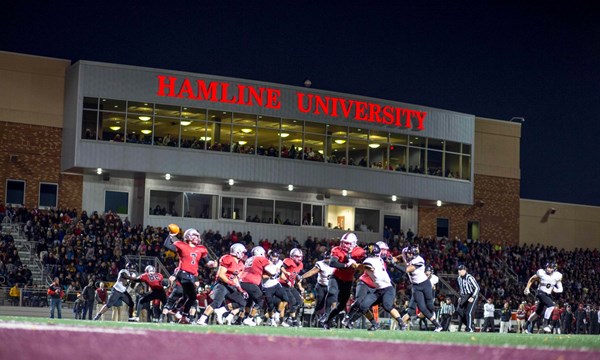A goal is scored, but no one cheers
What’s the difference between a scrimmage and a real game when there are not any fans in the stands to watch sports teams compete?
March 10, 2021
“The music’s blasting, everyone’s just so excited, you just feel that excitement. It’s been a year now since the last meet…it was just, it was just incredible,” First year softball player Ali Kimball said.
Kimball had recently finished recording the season-opener gymnastics meet, which also happened to be the team’s senior night. It would be disingenuous to say there were no tear streaks on her cheeks.
Anyone who has been to a high-intensity sports game can tell you that nothing matches the energy in that gym or on that field or by the deck. It is palpable. One of the biggest losses of this altered season is the restriction of spectators at events. The whole Hamline community feels the absence of sports on campus.
“A lot of the bonding that happened with the baseball team happened at other sporting games where we’re just like sitting in a section by ourselves,” junior baseball player Hayden Ring said.
Ring and the other members of the baseball team would often watch the women’s hockey games as they were considered sister teams.
“It’s made us all value the experience of not only just supporting our own team but supporting other teams on campus,” sophomore swimmer Aubrey Chavarria said.
The athletes on the courts, fields and pools feel the lack of fans just as much, no matter how many spectators their team averaged pre-COVID-19.
“It’s just not as loud,” Chavarria said. “We aren’t used to a whole lot of spectators, but still, it’s something.”
Only those essential to the event are allowed to be there. In an effort to limit exposure, many sports are helping host and run other sporting events. This prevents any unnecessary risk of introducing another student into the athletic environment.
The Athletics Department held many events in normal years to help foster the feeling of community within Hamline. However, without these social opportunities, many chances to make connections outside the classroom are lost to students.
“We would go to other games or other meets… SAAC would hold events and all the athletes would go,” Chavarria said. “It’s been kind of weird, you feel kind of disconnected from the rest of athletics.”
Chavarria, originally from Arizona, credits most of her friendships to her involvement with athletic programs such as SAAC, the Student Athletic Advisory Committee.
“It assimilated me to the Hamline environment a lot easier, having people to guide me through it,” Chavarria said.
Sports are also a major motivator for college athletes to continue to strive for success and it heavily influences their college decisions.
“It’s been pretty brutal,” Ring said. “Not having the sports aspect is a big thing because I did come up here to play baseball so it was a little bit tough having that stripped away.”
First years have never had the chance to experience a game played by their own college team, and this has heavily impacted this class’s connection to the school.
“It was just kinda the first time I saw that Hamline energy, like live and in action with people,” Kimball said. “It felt so good to be in a place where there’s a group of people that’s a community.”
This is not to say that other classes at Hamline haven’t felt the impacts of disrupted seasons just as much. Many athletes have chosen to take a leave of absence or else redshirt for a year in order to preserve their playing time for a season where normal play can resume.
Many students can agree that school simply doesn’t feel like school without the constant stream of games and events to attend, and trying to balance school work with social life is an important part of learning to live on your own.
“I miss the feeling of FOMO,” Ring said.
As the winter sports seasons come to an end and spring sports start to compete, there is no telling what a new season will bring by way of spectators and available games.
“I’ve never met a group of athletes until now who have pushed so hard without even knowing if there’s going to be anything,” Chavarria said.
Even though the only thing consistent about these crazy times is the inconsistency, the hope for many athletes and fans to cling to is the memory of what once was and what could be again.

